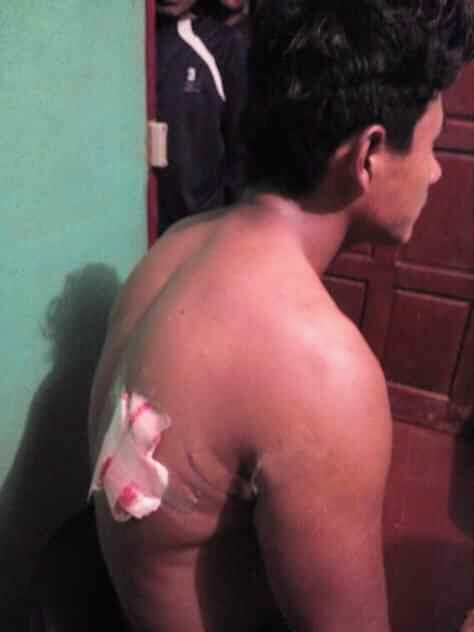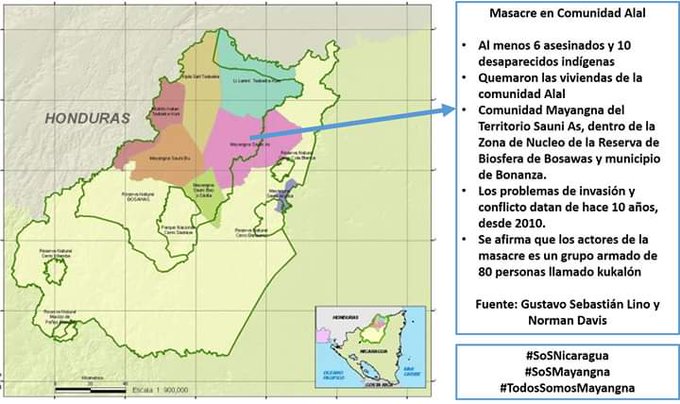Impunity Facilitates the Killings of Indigenous People in Nicaragua’s Bosawas Reserve

Will Fernandez, member of an indigenous community suffered a bullet wound in the head during an attack by land squatters on the Mayagna Sauni territory inside the Bosawas Biological Reserve. Courtesy photo
The State’s permissiveness over the last decade has left a trail of death, grief, deforestation, and a more pronounced agricultural frontier in the reserve area.
By Ivette Munguia (Confidencial)
HAVANA TIMES – The murder of a group of indigenous peoples in the Mayagna Sauni As territory within the Bosawas Biological Reserve, is the consequence of years of impunity on the part of Daniel Ortega’s regime.
For more than a decade, his government has ignored the demands of the indigenous communities for help in protecting their lands, which have been invaded by squatters. The regime’s failure to bring these invaders to justice has left a trail of death, grief, deforestation and an agricultural frontier ever more pronounced.
According to the “Never Nicaragua” Human Rights Collective, the murders in the indigenous communities are “systematic practices going back over a decade”. The Human Rights group adds: “[the murders] are only possible because of the permissiveness of the Nicaraguan State, with the clear and evident complicity of the National Police and the Nicaraguan Army – be it through actions or omissions – with the squatters who remain within the attacked territories.”
According to those in the community, the massacre that occurred this past Wednesday, January 29, in the Mayagna Sauni As Territory, left at least six members of the indigenous group dead, while another ten are missing. The deaths occurred during an armed attack by a group of at least 80 land invaders. In contrast, the National Police reported only two dead.
Two consecutive attacks
The leaders of the communal government of Alal issued a public denunciation, noting that Arly Samuel Gutierrez was murdered in an initial attack, while Centeno Indalecio and Marconi Jarquin, who alerted the other residents to the presence of the armed group, were wounded.
“The women, children and elders fled the community, while the men remained to defend their homes. Shortly thereafter, they were attacked by an armed group that opened fire on the community, burned 16 houses, including the pastoral house, and killed all the animals,” the statement specified.
In that second attack, Juan Emilio David Gutierrez was killed, and resident Will Fernandez was wounded by a shot in the head.
The communal authorities have identified eight other missing persons: Navarro Miguel; Efraín Miguel Valle; Víctor Díaz; Transito Mesa Bruno; Navarro Miguel Valle; Carlos Bruno; Econias Miguel Barcio; and Martian Miguel Dixon, all of them members of the communal government and community forest protectors.
No justice from the State

The human rights advocates felt that in Nicaragua there’s “a double standard in the protection of life and of the indigenous territories.” On the one hand, “the armed invaders act freely, with the consent of the Nicaraguan Army and National Police;” but on the other hand, “they’ve justified operations to execute people who oppose (the regime), accusing them of being criminals.”
Fundación del Río director Amaru Ruiz noted that worse than the attacks on the communities are the ten years of impunity and the scant importance that the Nicaraguan State has given the demands of the indigenous communities.
“The most dangerous element in all this is that the murders that have occurred in the rural areas – those of invaders, as well as those of members of the indigenous communities – have all gone unpunished. I don’t know of any case involving human rights in the indigenous communities where justice has been done,” Ruiz emphasized.
The environmentalist lamented the “negligent actions” of the national authorities. He underlined the fact that they can see no intention on the part of the State to attend to the situation. “Despite the denunciations, the trips to the capital, all the evidence, and everything that’s been done around the topic,” there’s been no action towards restoring the situation of the indigenous territories.
They were already under threat
To Ruiz, the impunity in these cases has become the determining factor, so that “other colonists, with other conflicts in other territories, find out in this way that they’re not going to be brought to trial, and that they can commit any criminal act against these indigenous communities,” he stated.
The opposition group Civic Alliance for Justice and Democracy condemned the massacre and recalled that the victims “had already received threats from the colonists at the end of November. The authorities of the Mayanga Sauni As territory had already filed public complaints about the threats and the ongoing land invasions. Nevertheless, the Nicaraguan State, once again, ignored the call for protection coming from the communities.”
Similarly, the Civic Alliance warned that the murders in the indigenous communities along Nicaragua’s Caribbean Coast constitute “a systematic practice of crimes perpetrated against the life and customs of the Indigenous Peoples, without any justice being done up until now. … with this new massacre, the situation in the Caribbean Coast takes on the characteristics of a process of ethnocide and extermination of the indigenous peoples of the Nicaraguan nation.”

Cejil: at risk of extermination
Authorities of the territorial government traveled to the Alal community to identify the other victims. However, at present, there is no further information, since the zone is difficult to access. The regime’s police also stated in a press note that they would send out a “technical team” to realize the investigative work.
Mayanga leader Larry Salomon emphasized that the community’s population fled because “the colonists destroyed everything. There’s no Army presence here, because they’re remote communities, if something is going to happen that threatens the indigenous families, it’s unavoidable, and for that reason measures are taken.”
The “measures” Salomon refers to are those of “organization and self-defense”. That is, to maintain watch, be ready with bows and arrows, machetes, and “hunting weapons, although there are only a few of these.” Said arms haven’t kept the indigenous groups from losing territory to the squatters, nor have they prevented the deaths of at least 20 residents since 2015, according to data from the Center for Justice and International Law (Cejil).
Cejil has warned that the indigenous communities of the Nicaraguan Caribbean run the risk of being exterminated and find themselves in a serious situation of abandonment and vulnerability due to the constant invasion of their territories.
The indigenous populations of the Nicaraguan Caribbean complain that the autonomy of their territories isn’t respected, and that the colonists have murdered, abducted, wounded and forcibly displaced the indigenous population along with causing the loss of 1.5 million hectares (3.7 million acres) of forest land since 2009.
